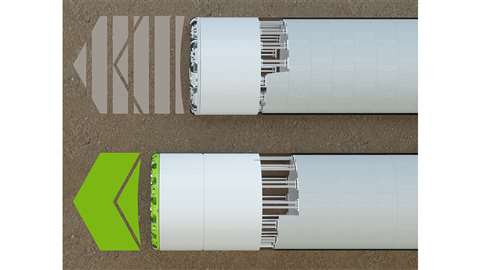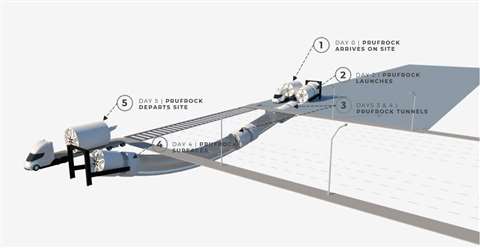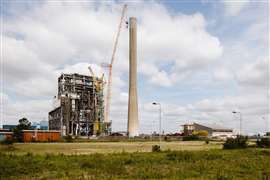6 ways tunnel boring machines are evolving
05 May 2023
Tunnel boring machines (TBMs) have a reputation for being lumbering and expensive. But innovations in the sector are increasing the speed at which they can operate, automating processes, and enhancing their ability to monitor complex geotechnical conditions.
Recent innovations include:
1) Harnessing the Industrial Internet of Things (IIoT)
TBM operators need to be able to take corrective measures if geotechnical conditions change. A TBM can have up to 5,000 sensors, collecting data at different rates on metrics including cutting surface performance, advance progress, and cutting wheel torque.
TBM manufacturer Herrenknecht recently developed a new IIoT platform to collect and manage data from wireless sensors and store it in a cloud-based central storage database.
The platform supports more than 2,000 TBMs, of which up to 700 can be in the field at any one time. The data is stored on computers in the control room of the TBM and uploaded to the cloud when there is internet connectivity - with the machines working up to 10-15km below ground, they can be offline for days, weeks or even months.
Herrenknecht has also uploaded 40 years’ worth of historic data in different formats to the platform.
2) In-tunnel diameter changes
US manufacturer Robbins claimed an industry-first in-tunnel TBM diameter change at the 8km-long Mill Creek Drainage Relief Tunnel in Dallas, Texas.
The tunnel has two diameters because it as it moves downstream, the flow requirements increase. As a result, the TBM was designed to go from 11.6m in diameter to 9.9m.
Robbins worked with the Southland/Mole joint venture to design a complete smaller machine first and then made a ‘kit’ that acted as a larger second skin.
When the time came to reduce the diameter of the TBM, it simply removed the second skin of the machine in a process that took about four months.
3) Autonomous tunnel boring machines
Malaysian infrastructure company MMC-Gamuda has developed what it claims is the world’s first autonomous tunnel boring machine (A-TBM) as a way of eliminating its dependence on scarce TBM operators.
It used the second line of the mass rapid transit (MRT) project in Kuala Lumpur as a test bed.
The plug-and-play system integrates into existing TBM hardware and sensors. It monitors the TBM’s processes and sends the data to a centralised control centre.
Initially, MMC-Gamuda tested the technology on a single machine to control its steering before extending it to other control parameters, such as advance rates and slurry controls.
Ultimately, 10 of 12 TBMs on the project were installed with the A-TBM system, boring through varying ground conditions. MMC-Gamuda said the next step will be to analyse tunnelling data and to allow the system to make predictions to yield better tunnelling solutions.
4) Continuous tunnelling in soft ground
 Herrenknecht won a Bauma innovation award for its developments in continuous tunnelling.
Herrenknecht won a Bauma innovation award for its developments in continuous tunnelling.
Herrenknecht has developed a method that allows continuous tunnelling in soft ground formations.
Tunnelling has traditionally had to pause after each excavation stroke to allow for the tunnel ring building sequence to take place.
The new continuous tunnelling system, which is 1.6 times faster, sees those thrust cylinders that push the machine forward during advance take over the force share of the cylinders that are retracted for ring building.
To ensure that the machine maintains its correct course during this process, a computer-driven Center of Thrust (CoT) system takes over the control of the pressures in the thrust cylinders from a manual operator.
Herrenknecht received the bauma Innovation Award 2022 in the ‘Machine Technology’ category for its new development.
5) ‘Porpoising’
 A graphic showing how The Boring Company’s Prufrock tunnel boring machine (TBM) can ‘porpoise’ through soft ground (Image courtesy of The Boring Company)
A graphic showing how The Boring Company’s Prufrock tunnel boring machine (TBM) can ‘porpoise’ through soft ground (Image courtesy of The Boring Company)
The Boring Company, based in the USA and founded by Elon Musk, launched the second iteration of its ‘Prufrock’ TBM in 2022.
The Prufrock is designed to launch directly from the surface, bore underground and re-emerge on completion, removing the need to excavate pits to launch and retrieve the machine, in a process known as “porpoising”.
The Boring Company claims that it can tunnel at a speed of a mile per week through soft ground, which is up to six times faster than its previous generation of TBM, the Godot+. The medium-term goal for the Prufrock is for it to tunnel at a rate of seven miles per day.
6) Plasma and superheated gas
San Francisco-based start-up company Earthgrid is developing a plasma micro TBM for the energy and utilities markets that it claims can dig underground 100 times faster than traditional methods.
Its plasma torches reach temperatures of 27,000C to blast through hard rock.
The torches are mounted on discs held out in front of a ‘rapid burrowing robot’ to blast away fragments backwards to be collected in small push carts. US-based start-up Petra has developed an autonomous robot called Swifty that can bore small tunnels between 40cm and 1.5m in diameter through hard rock for utilities. It uses a proprietary mix of superheated gas up to 1,800C.
STAY CONNECTED


Receive the information you need when you need it through our world-leading magazines, newsletters and daily briefings.
CONNECT WITH THE TEAM











